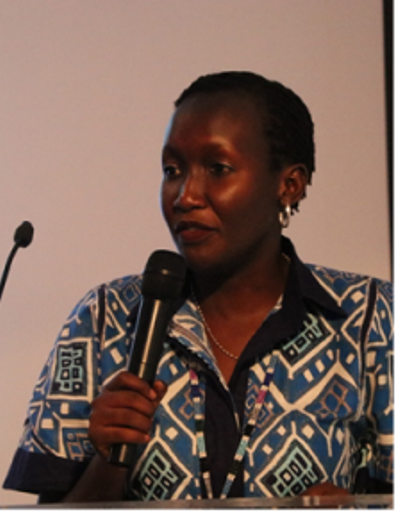Eng. Irene Kaggwa Ssewankambo, the UCC Acting Executive-Director
As many Ugandans continue to stay and work at home following the COVID-19 imposed lockdown, there is increased demand for Internet connectivity to facilitate work, business or keeping in touch with loved ones. However, data bundle usage remains a mystery to many people, leading to suspicion that they are being ripped off by the service providers. But as this article explains, subscribers hold the key to their data bundle usage, only that many don’t know how to use it.
Data speed and bandwidth; what is the difference between these?
The Internet is like a pipe or a road over which information moves. It is actually a network of millions of public and private electronic networks all over the world that are interconnected, enabling information to be exchanged. Data is the form in which the information moves around the Internet.
To send and receive information from the Internet, one needs to have a connection, which is provided by an operator or service provider (also referred to as an Internet access provider).
Data speed is the rate at which the data is transferred across your connection. This is typically measured in bits per second (bps). Depending on the connection, this will be in kbps (Kilo bps), Mbps (Mega bps), or Gbps (Giga bps).
The bandwidth is the size of the ‘pipe’. It is the capacity of the Internet connection (the pipe) in terms of the maximum volume of data that can be transmitted in a given amount of time. The larger the size of the pipe, the more data that can be transferred per second.
Data throughput, on the other hand, is how much data gets transferred from one point on the network to another.
Can I only connect to the Internet via a mobile network?
There are different types of Internet connections, offering different performance in terms of data speed and mobility. These include optical fibre, cable, ADSL (Asymmetric digital subscriber line) that uses traditional fixed telephone line connections, satellite (VSAT – very small aperture terminal), WiFi, and 3G/4G mobile networks.
The different types of connection are associated with various pros and cons. However, the choice of connection is typically dependent on your requirements or needs, e.g.:
- The location at which you desire to access/use the Internet services
- Whether you need a connection for a fixed location or you shall be mobile
- Whether you are obtaining a connection for home, work or individual use
- The speeds and reliability of service that you need.
The following are recommended in determining the type of connection:
- Determine what speeds and reliability you need. You want an Internet connection that is fast enough and offers you the performance quality suited for services and applications you want to use the Internet for. You don’t want to pay for a lot more than you will end up using. There are a number of tools available on the Internet that can help you in evaluating your speed needs, such as https://www.verizonwireless.com/freedom/datacalculator.html
- Check which licensed operators are able to provide services in the area(s) in which you require Internet access. Coverage areas differ from operator to operator.
- Seek out and study information on the following from the operators that are able to provide services in the location(s) desired:
- Packages offered and associated pricing
- Data speeds
- Installation and equipment requirements and costs
- Terms and conditions of service (service level agreement)
- Compare the offers of the different operators offering service in your desired area. The accredited website http://kompare.ug/data/mobile-internet-rates/ can assist you in the case of wireless services.
How is Internet usage billed?
Internet subscriptions are either paid for in advance of consumption (prepaid) or bound by contract for post consumption (postpaid) payment arrangements.
A data bundle is like a token. Every time you use the Internet over that connection, you use a part of your data allowance or credit. The amount of data you use, though, does vary depending on the service or application you are using or accessing over the Internet.
Data usage is billed based on the volume of data sent and received via the Internet connection and not the time spent connected to the Internet. It is typically in packages measured in megabytes (MB) and gigabytes (GB).
A data bundle may be associated with a specific validity/expiry date or can be unlimited in terms of expiry date. If the bundle reaches the validity date and expires before the bundle is depleted, it is foregone.
What are the factors that may affect the speed at which your data bundle is used up?
Anything you do on your phone or computer that accesses the Internet eats into your data bundle. So when you download or send emails, browse the Internet, send and receive messages over WhatsApp, check Facebook and Twitter, watch videos on YouTube, download movies from Netflix, you use the Internet and therefore eat into your data bundle.
However, different apps use different amounts of data. Downloading applications (apps), playing online video games, streaming music, and watching videos use a lot of data when compared to the use of location, weather, and social media apps. Similarly, watching video online is one of the quickest ways to consume your data.
The size of the pipe (the bandwidth) also affects the data speed. A key characteristic that distinguishes the mobile technologies -2G, 3G and 4G is the capacity (bandwidth) and thus data speed. When using a smartphone to download a file using a 2G, it will take a longer time to download than downloading the same file on a 3G network connection and on 4G.
However, this does not imply that 4G uses more data than 3G, but due to the faster data speed, your data is likely to be used up much faster. This is because the fast speeds will enable you to easily do more on the Internet, such as downloading one item after another, thus increasing your usage. Imagine, if you usually take an hour to download a movie and now you are able to do so in a matter of seconds. You are likely to instead download more than one video, or do so more frequently.
Various apps such as WhatsApp have also evolved over the years in terms of their capabilities and abilities, resulting in these having higher data needs than before. Viewing of videos and high-resolution images on applications such as WhatsApp, Facebook and Instagram consumes more data than just plain text. Additionally, apps such as cloud services that provide mirroring or back-up services usually continue to run as long as there is an internet connection.
For feature phones, most apps and services only connect to the Internet on demand. On smartphones, however, apps can fetch any new information and update themselves. As a result, when an update of an app becomes available, the phone owner has a period of about a week to update the app. After this period, if the update wasn’t done, the update of the app starts to download in the background. This can result in multiple apps running updates at the same time.
If the updates fail to be completed in the particular session due to low storage on the phone, depletion of the data bundle and other interruption, the update starts all over again. The app store also periodically checks to see if any of the apps installed on the phone has an update available. Additionally, apps such as Facebook, Twitter, Instagram, and Outlook mail periodically synchronise to check for any new activity or content updates on the user’s account.
Notably, when you add more devices or users onto your subscription (either via a modem or through tethering on your mobile phone), then your level of usage increases and the demand expands to include the background and auto-synchronisation apps such as Outlook mail on a computer. Note that some devices are more bandwidth-hungry than others, for example iPhones.
One factor that is likely to be a surprise to many is the use of Virtual Private Networks (VPNs). The encryption process in using a VPN adds about 10-15% more data usage. Using a VPN could, therefore, eat into your data bundle significantly, depending on what kind of content you are accessing using your VPN. The stronger the encryption, the higher the data overload. It is also common to have data speeds impacted with a resultant slower connection.
Another critical aspect to note is data roaming. Data roaming is when you use your subscription to connect the Internet outside of your home network coverage range, for example, when travelling abroad. At the time when you use your Internet subscription out of your home network, the phone is connected to and using network resources of another operator, which generally results in higher data charges due to compensation to the other operator for facilitating this connectivity.
Data consumption on an Internet connection can be likened to fuel consumption by a car, as illustrated in the table below.
| Fuel consumption | Data consumption |
| How fast you drive | Data speed |
| The age and condition of your vehicle | What kind of connection are you using? 2G, 3G, 4G? |
| Traffic and road conditions | The number of users, devices and/or applications sharing your internet connection, e.g. mobile hotspot, shared modem, etc. |
| Temperature and weather | The number of users sharing the network base station cell that is serving you. As the number of users connected to the base station increases, the speed that each user will be able to achieve is likely to drop. This is also related to radio conditions such as the distance of the user from the base station |
| Using air conditioning and other powered accessories | Using VPN |
| Using all-wheel and four-wheel drive | High definition video and high-quality audio streaming use more data |
How can you monitor your Internet usage?
There are various apps and tools available on the Internet that can help you check your data speed, your connection and even conduct a detailed traffic analysis.
One such application is available on your smartphone. This can be accessed using the following process:
- Tap ‘Settings’ on the main menu
- Tap ‘Network & Internet or Connections’
- Tap ‘Data usage’. On some Android phones, you might see this option immediately in the Settings menu
- You will see a graph of your usage going back one week. You can change this cycle to match the dates of your data bundle to provide a better insight into your data usage
- If you scroll further down, you can now check how much data each app that is on your phone is using.
However, it is important to point out that some operators measure data usage differently. We, therefore, recommend that you check with your operator to provide you with their measurements.
Some operators also provide a tracker or app to subscribers to facilitate them in monitoring their data usage.
What can you do to improve your rate of data usage?
Specifically, to improve your mobile data usage, you need to address the causes of high usage highlighted above. Accordingly, the following are proposed:
- Disable auto-downloads for updates
- Turn off Auto-sync data (Go to ‘Settings’ then ‘Accounts’ then ‘Auto-sync Data’)
- On the Data usage feature on the phone, tap on the app to ‘Restrict background data’
- If you have access to a trusted WiFi connection, periodically check for updates and update as often as you can while using the WiFi
- Delete unused apps
- When using social media apps like Facebook, switch off ‘Autoplay’ and decide which of the videos you want to open and watch
- Switch off Data roaming (Go to ‘Settings, then hit ‘More’. Scroll down to mobile networks, and under this, you will see ‘Data roaming’)
- Restrict your video streaming to “low quality”. Remember the default is “auto” and adjusts based on the bandwidth of the provider
- Do not share your MiFi or router or phone (if tethering) passwords with other people without regulation
- Change your Netflix setting. Select the Menu icon, App settings, Cellular data usage, and then Standard definition (SD) quality of stream.





